Home > Mary Evans Prints Online > Inst. of Mechanical Engineers
Mhow-ke-Mullee Viaduct, 3, 000 men employed
![]()

Wall Art and Photo Gifts from Mary Evans Picture Library
Mhow-ke-Mullee Viaduct, 3, 000 men employed
Mhow-ke-Mullee Viaduct, 3, 000 men employed; Khumnee Hill; mouth of Tunnel no 11; at 4 3/4 miles Date: 1856
Mary Evans Picture Library makes available wonderful images created for people to enjoy over the centuries
Media ID 5085257
© Mary Evans Picture Library 2015 - https://copyrighthub.org/s0/hub1/creation/maryevans/MaryEvansPictureID/10510724
1856 Alice Bhore Clowser Ghat Peninsula Swainston Tredwell
EDITORS COMMENTS
Mhow-ke-Mullee Viaduct, 3,000 Men Employed (1856): A Sight to Behold This photograph captures the monumental progress of the Indian Peninsula Railway during the mid-19th century, specifically the construction of the Mhow-ke-Mullee Viaduct in 1856. The image, taken at Khumnee Hill, shows the mouth of Tunnel No. 11 and the impressive structure that would become a vital part of the railway system connecting Bombay to the north. With the date set in 1856, this photograph documents an essential period in Indian transportation history. The Indian Peninsula Railway, a British enterprise, was revolutionizing the way goods and people moved across the Indian subcontinent. The railway network was expanding rapidly, and the construction of the Mhow-ke-Mullee Viaduct was a testament to the ingenuity and determination of the engineers and laborers involved. The photograph depicts an impressive scene with 3,000 men working on the viaduct, showcasing the sheer scale of the project. The men, dressed in traditional Indian attire, can be seen working on various sections of the viaduct, which was being built using the cut-and-cover method. The laborers, under the supervision of engineers like Tredwell, Clowes, and Swainston, worked tirelessly to complete this engineering marvel. The Mhow-ke-Mullee Viaduct, a massive structure spanning over 1,000 feet, was a critical component of the railway line. It allowed the trains to pass over the Bhore Ghat, a steep and challenging terrain, and ensured the safe and efficient transportation of goods and passengers between Bombay and the north. This photograph is a fascinating glimpse into the past, offering a unique perspective on the construction process and the people involved in building the railway network that would forever change the way India was connected.
MADE IN THE USA
Safe Shipping with 30 Day Money Back Guarantee
FREE PERSONALISATION*
We are proud to offer a range of customisation features including Personalised Captions, Color Filters and Picture Zoom Tools
SECURE PAYMENTS
We happily accept a wide range of payment options so you can pay for the things you need in the way that is most convenient for you
* Options may vary by product and licensing agreement. Zoomed Pictures can be adjusted in the Cart.


